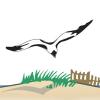While recently walking our dogs on Lewes Beach, I was quite surprised to see the unpainted lifeguard chairs. Lifeguard chairs are historically a bright, crisp white, easily identifiable from a distance.
My reason for commenting on this is more than tradition. I worked as a guard at Lewes for a few years and speak from experience. Admittedly that was long ago, but some things do not change, or at least they should not.
Of course, the primary function of the chair is to elevate the guard to facilitate monitoring the water and beach in his/her area. That said, there is another important aspect to having a conspicuous white chair. Recognition: On a busy weekend with the beach packed with visitors and a sea of umbrellas, that stark white chair can be easily located by anyone needing assistance. The chair identifies where help can be found quickly, even if the guard(s) may be briefly on the beach or in the water. Why might this be important?
On most summer weekends, many families with young children enjoy our beautiful beach and the calm waters of the bay. It is not uncommon for children to wander off and be temporarily lost in the crowd, a frightening moment for any parent. Notifying the nearest guard usually resolves that situation in short order.
Jellyfish stings and minor cuts/bruises can be attended to and advice provided for beach-goers seeking assistance on any number of matters. It may be just directions to the nearest emergency room for a more serious injury, which sometimes occurs during beach play.
I remember vividly an incident when a lady approached the chair while I was down at the water’s edge cautioning some kids at the time. It seems there had been a dispute, and her husband managed to injure his big toe, broken actually, while trying to kick someone in their party. She seemed particularly annoyed, suggesting he should just walk to the ER. An unpleasant and embarrassing incident, but she came to the chair for assistance.
When there is the occasional unruly person creating a disturbance, the first target for assistance is that white chair. People do not usually want to overreact and wander through the parking lot looking for the police. Informing the nearest lifeguard can often defuse a situation or at least initiate appropriate action.
Those examples should be sufficient to make the point. That white lifeguard chair stood as a symbol for prompt and reliable assistance for many minor issues that may arise during a day at the beach...and a few not so minor, such as a missing child.
The natural wood look may please some aesthetically or environmentally, but it minimizes the chair’s significance. I won’t go so far as to say it is an insult, but it borders on it. Lifeguards obviously do not wear clearly recognizable uniforms for the most part. Maybe all in matching colored bathing suits and T-shirts, but that’s about it. That bright white chair serves as their collective uniform. I vote to return to the White Chair. The “chairs from a yard sale” appearance falls well short of the standard that has been maintained for decades.
The opinion of one old Lewes Lifeguard.
William (Ted) Hill, VMD
Lewes

















































